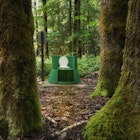
Explore the mysterious signs and symbols of Qatar's Al Jassasiya rock carvings
Sponsored by
Dec 15, 2021 вҖў 6 min read

The Al Jassasiya rock carvings depict images of human life such as footmarks and rosettes, important animals such as fish, ostriches and scorpions, and dozens of mysterious, cup-shaped indentations В© Alizada Studios / Shutterstock
Qatar might be one of the worldвҖҷs newer countries вҖ“ this year marks the 50th since its independence вҖ“ but this small slice of land in the Arabian Peninsula has been inhabited for millennia and mentioned in the writing of Greek geographer and historian Herodotus as far back as the 5th century BC.
After that, what happened in the land we now call Qatar relies more on oral traditions than written records, and most of its known history only dates to around the 18th century. Evidence вҖ“ such as flint spearheads, pottery shards and burial mounds near Umm Salal Mohammed ВӯвҖ“ of the early inhabitation of Qatar (from 4000 BC) exists. However, like many nomadic areas the peninsula has few clues to shed light on its ancient lineage.
One fascinating exception, however, lies an hour from downtown Doha, near the northern coast of Qatar, where the petroglyphs of Al Jassasiya tell a fascinating story.

Mysterious symbols
The Al Jassasiya rock carvings, some 900 images spanning an area 2300 feet (700m) wide, is the most extensive collection of petroglyphs in the area and probably the most impressive. They depict images of human life such as footmarks and rosettes, important animals such as fish, ostriches and scorpions, and dozens of mysterious, cup-shaped indentations, usually only 1-15 cm deep and placed in rows.
These carvings might draw a direct line to modern Qatar. Images of dhows, a type of boat still in use today, are scattered throughout the collection. Today, dhows are primarily elegant pleasure craft, but over the centuries they have been used to transport goods to the peninsulaвҖҷs markets, for fishing and travel, and especially for pearl diving. In fact, the long oars on the dhows depicted in the Al Jassasiya rock carvings might indicate that they represent ancient pearl diving vessels. This grueling profession was an important part of life in the Gulf and a major contributor to the regionвҖҷs economy before oil was discovered.
Other carvings resemble pits of different sizes, which are often connected to channels reaching up the slope of the jebel (hill) in which theyвҖҷre carved, giving the impression the pit is moving towards the sea. These shallow pits are a complete mystery, but theyвҖҷre often found around large groups of other carvings.

How old are they?
Perhaps the biggest mystery is the age of these rock carvings, and there has been much discussion and debate on this subject. Some estimates say the oldest could date back to the Neolithic age, which started around 8000 BC. Archaeologists believe they go back as far as the 3rd century BC, while others say the 8th to 10th century AD is more likely.
A variety of modern techniques have been used to date these petroglyphs over the years, but so far tacking down a precise date has proven difficult. The petroglyphs in Al Jassasiya are unique in the gulf region because of their design elements and their occurrence in concentrated areas, so theyвҖҷre hard to compare to other sites.
Adding to the mystery, some of the petroglyphs form a definite pattern while others seem more random, suggesting they were added in multiple times in history.

Remnants of ancient life
The shallow, cup-shaped depressions found at the site are an enigma. Because theyвҖҷre only a few centimeters deep, itвҖҷs possible they were carved to hold pearls. ItвҖҷs also possible they were used in an early version of a board game similar to mancala.
Derived from the Arabic word naqala, which means вҖңto move,вҖқ mancala is one of the oldest board games in the world, with historical and archaeological evidence dating it as far back as 700 AD. The rules of the two-player turn-based strategy game vary from place to place, but the general aim is to collect counters (usually stones, beads or seeds) by moving them from cup to cup and into your stores. In Qatar, the game is known as Al Haloosa or Al Huwaila, and itвҖҷs still played today.
Also in the Al Jassasiya area, evidence of much older residential settlements has been found, with shards of pottery dating to the Ubaid period (6500 BC to 3800 BC). The age is named after the site in southern Mesopotamia (ancient Iraq) where this type of pottery was first excavated. Settlers here probably had trading ties with Mesopotamia and could have come down on fishing expeditions and lived here or traded their decorated pottery.
It was during the Ubaid period that people formed villages and lived as a community. They farmed their land through irrigation, domesticated animals and fished, forming the basis of early urban civilization. For a walk back in time, the pottery that was excavated from Al Jassasiya is exhibited in Gallery 3 at the National Museum of Qatar.

Visit this well-kept secret
For hundreds if not thousands of years the Al Jassasiya Rock Carvings were lost to history. After they were rediscovered around 1957, they still were not properly studied and researched until 1974. Even until very recently, their whereabouts were all but a secret вҖ“ only those in the know with a 4WD could find them.
Today the site is more accessible, and itвҖҷs protected by law. The area is fenced off, but you can see the petroglyphs accompanied by a local tour guide who will have the necessary permissions to visit this historic site.
Even better, consider taking a tour with the . Becoming a Culture Pass member of the Museums grants access to several archaeological sites вҖ“ including exclusive access to Al Jassasiya вҖ“ through the museumвҖҷs Atharna program. These tours put the cultural background of this beautiful land into historical perspective, highlighting the ancient civilizations and archaeological history, and how they are significant to the development of Qatar.
The also provides workshops to further help you understand QatarвҖҷs deep-rooted past and the history, and along with the tours, these are open only to .
With the free Culture Pass Basic, visitors have access to one tour and workshop each year. With a Culture Pass Plus (QR 200 вҖ“ About $55 USD) or Culture Pass Family (QR 350), you can take unlimited tours to QatarвҖҷs historical landmarks and participate in all the workshops.

How to learn more
Pair your adventure to the Al Jassasiya rock carvings with a visit to the National Museum of Qatar, which will shed more light on the petroglyphs and provide a glimpse into QatarвҖҷs historical background. Here youвҖҷll find huge replicas of some of the carvings so you can study them more closely.
When visiting the Al Jassasiya site itself, make sure you donвҖҷt touch or walk on the petroglyphs, and do not try to remove anything from this important archaeological site. Your photographs and a new understanding of the history that surrounds Qatar will be all you need to take from this mysterious and fascinating glimpse into a bygone era.
You might also like
Sponsored by Qatar Tourism
As a travel entertainment and inspirational media outlet, we sometimes incorporate brand sponsors into our efforts. This activity is clearly labeled across our platforms.
This story was crafted collaboratively between Qatar Tourism and ПгёЫБщәПІКјҙКұҝӘҪұ. Both parties provided research and curated content to produce this story. We disclose when information isnвҖҷt ours.
With sponsored content, both ПгёЫБщәПІКјҙКұҝӘҪұ and our brand partners have specific responsibilities:
Brand partner
Determines the concept, provides briefing, research material, and may provide feedback.
ПгёЫБщәПІКјҙКұҝӘҪұ
We provide expertise, firsthand insights, and verify with third-party sources when needed.
Explore related stories


 ArtGlenstone is an unmissable, immersive cultural destination. HereвҖҷs why you need to visit this spring
ArtGlenstone is an unmissable, immersive cultural destination. HereвҖҷs why you need to visit this springMar 22, 2023 вҖў 5 min read
 Art and CultureTop 13 things to do in Qatar, from fortresses to camel racing and atmospheric markets
Art and CultureTop 13 things to do in Qatar, from fortresses to camel racing and atmospheric marketsAug 9, 2022 вҖў 8 min read


 Festivals & EventsFrom scorching summers to wintertime festivals, hereвҖҷs when to visit Qatar
Festivals & EventsFrom scorching summers to wintertime festivals, hereвҖҷs when to visit QatarJul 14, 2022 вҖў 6 min read

 Festivals & EventsWhere in the world are people planning to travel in 2021?
Festivals & EventsWhere in the world are people planning to travel in 2021?Jul 14, 2020 вҖў 2 min read

